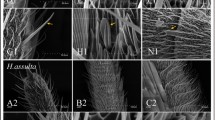Summary
Sensilla trichodea of the silk moths, Antheraea pernyi and Bombyx mori, were reconstructed from serial sections after freeze substitution. The volume and surface area of the different sensillar cells were calculated from the area and circumference of consecutive section profiles. A. pernyi and B. mori differ largely in the size of the sensory hair and the larger outer dendritic segments as well as in the volume of the receptor lymph within the hair, while there are only small differences regarding inner dendritic segments, receptor-cell somata, trichogen and tormogen cells and the volume of the receptor lymph below the hair base.
In each sensillum the two (or three) receptor-cell somata, dendrites, and initial axonal segments differ significantly in volume and surface. The apical cell membranes of the trichogen and tormogen cells, which border the receptor-lymph cavity and which are the presumed site of electrogenic cation pumps, are deeply invaginated and enlarged by microlamellae and microvilli, so that their area is twice that of the remaining basolateral cell membrane. In contrast to mechanoreceptors, the trichogen cell is the largest auxiliary cell and has the largest apical membrane surface. The morphometric data are discussed with regard to recent electrophysiological observations.
Similar content being viewed by others
References
Cole KS (1972) Membranes ions and impulses; a chapter of classical biophysics. University of California Press, Berkeley
De Kramer JJ (1982) The electrical circuitry of an insect olfactory hair. Proc 5th ECRO Congress, University of Regensburg, p 16
Ernst KD (1969) Die Feinstruktur von Riechsensillen auf der Antenne des Aaskäfers Necrophorus (Coleoptera). Z Zellforsch 94:72–102
Gnatzy W, Weber KM (1978) Tormogen cell and receptor-lymph space in insect olfactory sensilla. Fine structure and histochemical properties in Calliphora. Cell Tissue Res 189:549–554
Harvey WR (1980) Water and ions in the gut. In: Locke M, Smith DS (eds) Insect biology in the future. Academic Press, New York, pp 105–124
Kaissling KE (1971) Insect olfaction. In: Beidler LM (ed) Handbook of sensory physiology Vol IV. Springer, Berlin Heidelberg New York, pp 351–431
Kaissling KE (1979) Recognition of pheromones by moths, especially in saturniids and Bombyx mori. In: Ritter FJ (ed) Chemical ecology: Odour communication in animals. Elsevier/North-Holland Biomedical Press, Amsterdam, pp 43–56
Kaissling KE, Thorson J (1980) Insect olfactory sensilla: structural, chemical and electrical aspects of the functional organization. In: Sattelle DB, Hall LM, Hildebrand JG (eds) Insect neurotransmitter, hormone, and pheromone receptors. Elsevier/North-Holland Biomedical Press, Amsterdam, pp 261–282
Kaissling KE, Kasang G, Bestmann HJ, Stransky W, Vostrowsky O (1978) A new pheromone of the silkworm moth Bombyx mori — sensory pathway and behavioral effect. Naturwissenschaften 65:382–384
Keil T (1978) Die Makrochaeten auf dem Thorax von Calliphora vicina Robineau-Desvoidy (Calliphoridae, Diptera) — Fein-struktur und Morphogenese eines epidermalen Insekten-Mechanoreceptors. Zoomorphologie 90:151–180
Küppers J (1974) Measurements on the ionic milieu of the receptor terminal in mechanoreceptive sensilla of insects. In: Schwartzkopff J (ed) Mechanoreception. Abh Rhein Westf Akad Wiss, Opladen, pp 387–394
Oschman JL, Berridge MJ (1970) Structural and functional aspects of salivary fluid secretion in Calliphora. Tissue & Cell 2:281–310
Phillips CE, Vande Berg JS (1976) Directional flow of sensillum liquor in blowfly (Phormia regina) labellar chemoreceptors. J Insect Physiol 22:425–429
Slifer EH (1970) The structure of arthropod chemoreceptors. Ann Rev Entomol 15:121–142
Steinbrecht RA (1969) On the question of nervous syncytia: lack of axon fusion in two insect sensory nerves. J Cell Sci 4:39–53
Steinbrecht RA (1970) Zur Morphometrie der Antenne des Seidenspinners, Bombyx mori L. Zahl und Verteilung der Riechsensillen (Insecta, Eepidoptera). Z Morphol Tiere 68:93–126
Steinbrecht RA (1973) Der Feinbau olfaktorischer Sensillen des Seidenspinners (Insecta, Lepidoptera) — Rezeptorfortsätze und reizleitender Apparat. Z Zellforsch 139:533–565
Steinbrecht RA (1976) Freeze substitution and freeze fracturing of insect sensilla without cryoprotectants. In: Ben-Shaul Y (ed) Proc 6th Eur Congr Electron Microscopy Jerusalem Vol II, Intertal, Givatayim, pp 111–113
Steinbrecht RA (1980) Cryofixation without cryoprotectants. Freeze substitution and freeze etching of an insect olfactory receptor. Tissue & Cell 12:73–100
Steinbrecht RA (1982) Experiments on freezing damage with freeze substitution using moth antennae as test objects. J Microsc 125:187–192
Steinbrecht RA, Gnatzy W (1982) Morphometric analysis of sex pheromone sensilla in the moths, Bombyx mori and Antheraea pernyi. Proc 5th ECRO Congress, University of Regensburg, p 83
Steinbrecht RA, Gnatzy W (1984) Pheromone receptors in Bombyx mori and Antheraea pernyi: I. Reconstruction of the cellular organization of the sensilla trichodea. Cell Tissue Res 235:25–34
Steinbrecht RA, Zierold K (1982) Cryo-embedding of small frozen specimens for cryo-ultramicrotomy. In: Electron microscopy 1982 Vol III, Dtsch Ges Elektronenmikroskopie, Frankfurt/Main, pp 183–184
Thurm U (1970) Untersuchungen zur funktionellen Organisation sensorischer Zellverbände. Verh Dtsch Zool Ges 1970:79–88
Vogt RG, Riddiford LM (1981) Pheromone binding and inactivation by moth antennae. Nature 293:161–163
Weibel ER (1979) Stereological methods Vol I Practical methods for biological morphometry. Academic Press, London
Weibel ER (1980) Stereological methods Vol II Theoretical foundations. Academic Press, London
Wiese K, Schmidt K (1974) Mechanorezeptoren im Insektentarsus — Die Konstruktion des tarsalen Scolopidialorgans bei Notonecta (Hemiptera, Heteroptera). Z Morphol Tiere 79:47–63
Author information
Authors and Affiliations
Rights and permissions
About this article
Cite this article
Gnatzy, W., Mohren, W. & Steinbrecht, R.A. Pheromone receptors in Bombyx mori and Antheraea pernyi . Cell Tissue Res. 235, 35–42 (1984). https://doi.org/10.1007/BF00213720
Accepted:
Issue Date:
DOI: https://doi.org/10.1007/BF00213720



